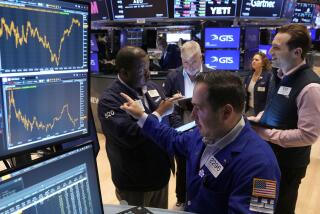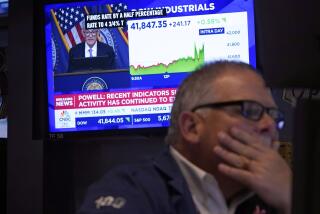FALLOUT FROM MEXICO’S FINANCIAL CRISIS : NEWS ANALYSIS : Caught Between a Rock and a Rate Hike : Federal Reserve: Greenspan must decide whether to delay another increase in interest to build support for a Mexican bailout.
WASHINGTON — Congressional opposition to a $40-billion loan package for Mexico has forced Federal Reserve Board Chairman Alan Greenspan to confront one of the most difficult political decisions of his career: whether to delay this week’s widely expected interest rate hike to build support for the Mexican bailout.
Greenspan has quickly found that his new role as a key player in Washington’s bid to rescue the peso is in direct conflict with his broader task of managing U.S. interest rate policy. The impact of a U.S. loan package to bolster the peso could be washed out by higher American interest rates that would strengthen the U.S. dollar against foreign currencies. Greenspan thus may find it difficult to ask Congress to pass the bailout package at a time when the Fed’s own policies could make that rescue effort more difficult to accomplish.
On the one hand, the Fed must convince Congress that the Mexican peso crisis is so severe that it could harm American interests. On the other, it must convince Congress that the peso problem is a trivial issue when it comes to the Fed’s overall monetary policies.
Senior Fed officials--most of whom still believe that the Fed will raise rates by one-half percentage point today or Wednesday--are clearly sensitive about their political dilemma.
“I think I’ll leave it to Greenspan to go up to Capitol Hill and explain why the $40-billion loan guarantees may now have to be a $45-billion package because we just raised interest rates,” said one Fed board member.
“If you were to say this puts us in a very awkward political position, I certainly wouldn’t argue with you,” added another Fed board member.
In fact, Greenspan’s decision to join Clinton Administration officials in an intensive--and very public--lobbying campaign in support of congressional passage of the Mexican aid package has sent jitters through the Fed, where officials see themselves as increasingly vulnerable to congressional attacks on both the Mexican plan and the Fed’s aggressive interest rate policies.
The Mexican crisis, touched off by the Dec. 20 devaluation of the peso, has prompted Greenspan to make rare joint public appearances before the press and Congress with Treasury Secretary Robert E. Rubin, and he has joined a lobbying team assembled by President Clinton that includes Rubin and Secretary of State Warren Christopher to push for the rescue plan.
*
That led Democratic senators last week to begin to question Greenspan’s dual efforts. A Fed rate hike will only intensify the debate as Greenspan continues his lobbying campaign for Mexican aid.
Senior Fed officials were hoping that the Mexican aid package would have been passed by Congress last week, before the Fed’s two-day Open Market Committee meetings today and Wednesday. Instead, they now find that congressional debate over the Mexican plan has dragged on so long that the Fed must deal with both issues virtually at the same time.
*
Greenspan, for example, is planning to testify before the Senate Banking, Housing and Urban Affairs Committee this morning on the Mexican aid plan--and then will rush back to the Fed’s headquarters in downtown Washington to chair the Fed’s monetary policy sessions.
“I’m sure the Fed does not like to have these two issues on the table at the same time,” observed Ross DeVol, an economist at the WEFA Group, a research firm in Bala Cynwd, Pa. “The Fed has to argue that it must raise rates because U.S. growth is unsustainably high, and so it needs to be reigned in to curb inflation,” DeVol added. “But the Fed also has to argue that the Mexican package is vital because the peso crisis threatens to drag down U.S. economic growth.”
Indeed, both Greenspan and President Clinton have argued repeatedly that hundreds of thousands of U.S. jobs tied to trade with Mexico could be in jeopardy should the Mexican economy collapse. They also have warned that the financial crisis could spread to other parts of the hemisphere if it is not addressed now.
Ultimately, most economists believe that pressure from the financial markets will force Greenspan and the Fed to go ahead with the rate hike. In the bond market, the betting is that this week’s rate hike will be the Fed’s last increase for the foreseeable future, and traders want the nation’s central bank to get it over with quickly to remove uncertainty from the financial markets.
A delay until the Fed’s next policy-making session in March would be widely interpreted as a sign that Greenspan was allowing monetary policy to be dictated by the Mexican crisis--and that could prove disastrous for his credibility.
“The Fed right now is in a damned-if-you-do, damned-if-you-don’t situation,” observed Alan Stoga, an international economic analyst at Kissinger Associates, a New York consulting firm. “I’m convinced that a delay in the rate hike will be immediately seen as caused by Mexico, and rates in the bond market will move up anyway.”
But in purely economic terms, one more Fed rate hike may not be enough to influence the outcome of the Mexican crisis. Mexico’s problems are so severe--a 42% devaluation of the peso has already pushed Mexican interest rates up to 30%, virtually ensuring a deep recession in the country--that one more rate hike in the United States might not be noticed.
*
“One-half point is not an issue for Mexico,” noted David Wyss, an economist with DRI-McGraw Hill, a research firm based in Lexington, Mass. “But the rate hike is important politically, since this could cause the Fed a lot of problems in Congress.”
Some Fed officials believe that the politics of the situation are so bad that the Mexican aid package is already dead in Congress. They wonder whether Greenspan and Clinton should not cut their losses and try a new approach.
* LAST-DITCH EFFORTS
Emergency Mexican aid legislation to be submitted. A1
* HARDER SELL
Ford downgrades hopes for Mexican car sales. D2
(BEGIN TEXT OF INFOBOX / INFOGRAPHIC)
Tumbling Currency
The Mexican peso plunged to a record low against the dollar amid doubts about a U.S. bailout. Pesos to the dollar, weekly closes except latest:
Monday: 6.35
Source: TradeLine, Bloomberg Business News
More to Read
Sign up for Essential California
The most important California stories and recommendations in your inbox every morning.
You may occasionally receive promotional content from the Los Angeles Times.










